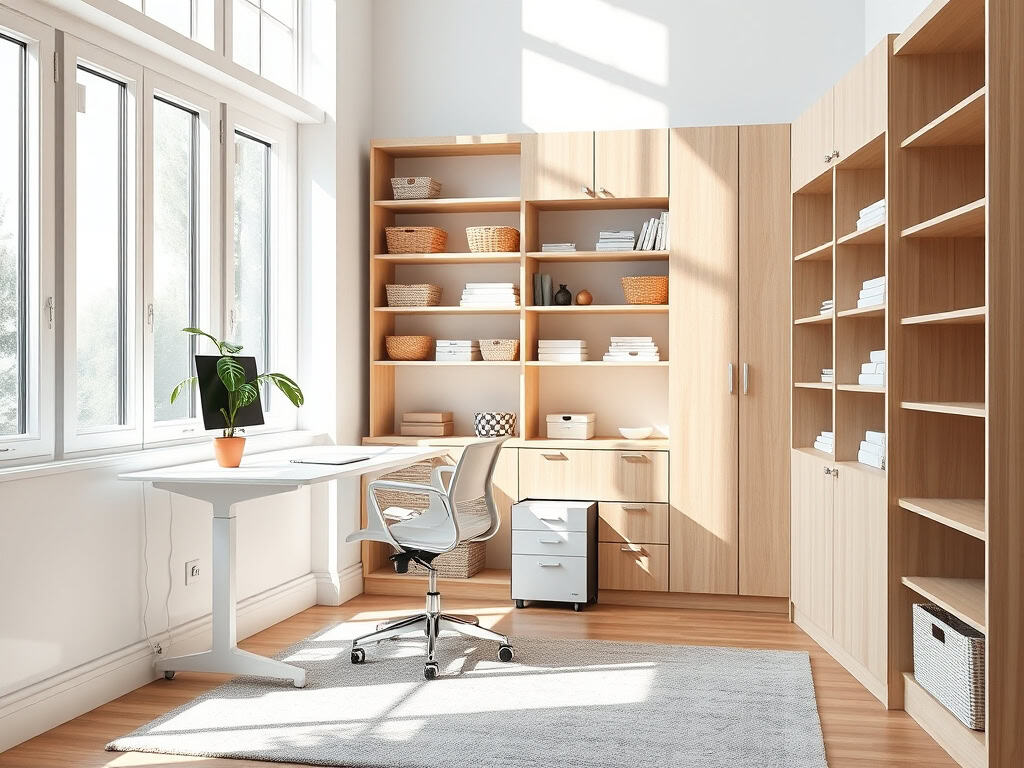Picture walking into a room that transforms from your productive workspace by day into an organized storage haven by night. If you’re struggling to make the most of your limited square footage, you’re not alone! I’ve helped dozens of clients maximize their space through creative solutions that blend form and function. Let me share seven game-changing ideas that’ll help you turn that cluttered catch-all room into an efficient multi-purpose space you’ll actually enjoy spending time in.

Vertical Storage Solutions for Small Office Spaces
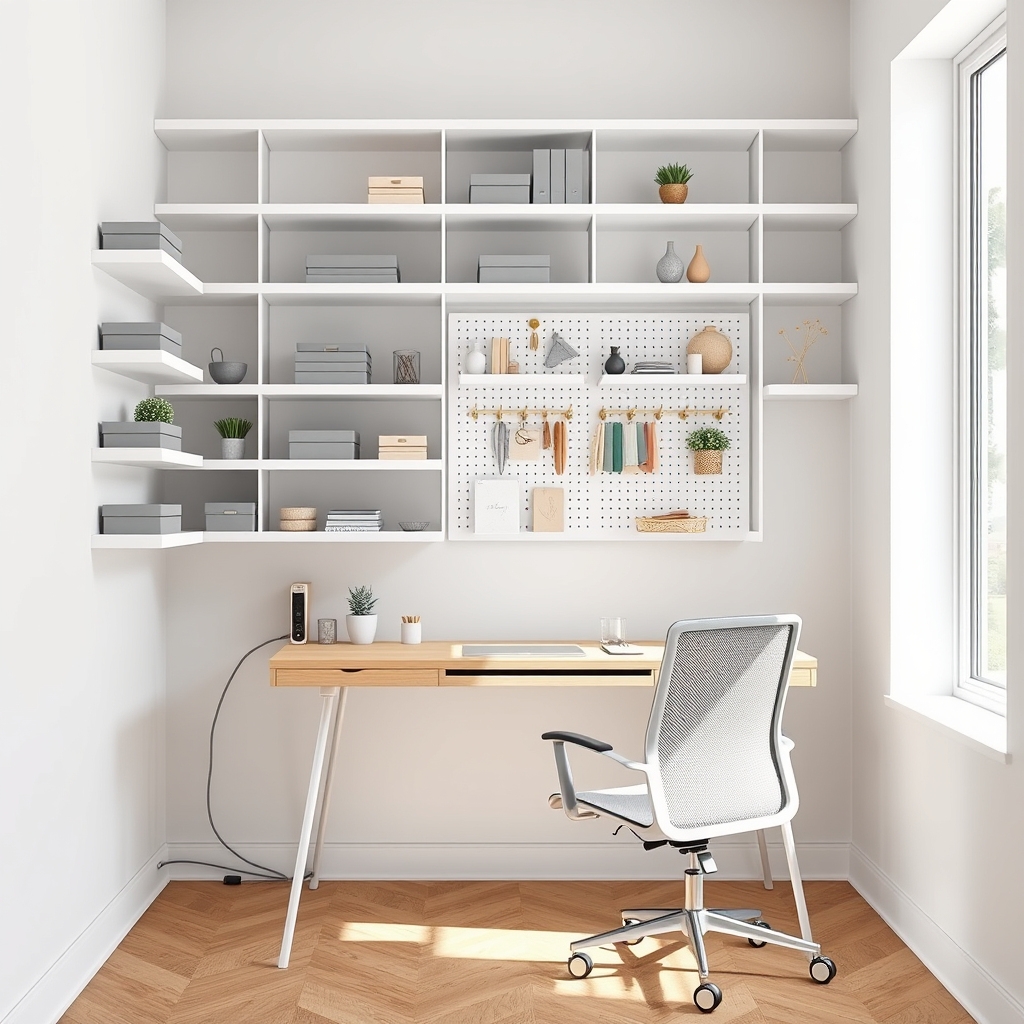
Making the most of vertical space in a small office is crucial for maintaining productivity and creating a clutter-free work environment. When floor space is limited, expanding upward allows you to maximize storage capacity while keeping essential items within reach.
Vertical storage solutions transform unused wall space into functional storage areas, freeing up valuable desk and floor space for essential work activities. This organizational approach not only improves efficiency but also creates a more visually appealing and professional workspace that can help maintain focus and reduce stress.
Required Items:
- Wall-mounted shelving units
- Floating shelves
- Over-door organizers
- Pegboards and hooks
- Cable management systems
- Storage bins and containers
- Wall-mounted file holders
- Command strips or mounting hardware
- Measuring tape
- Level
- Drill and screwdriver
- Stud finder
Start by assessing your wall space and mapping out potential storage zones, using a measuring tape to determine dimensions and a stud finder to locate secure mounting points.
Install your primary shelving systems at varying heights, keeping frequently used items between waist and eye level for easy access. Mount pegboards in areas where you need flexible storage options for tools and supplies that change regularly.
Position floating shelves strategically to create designated zones for different categories of items – reference materials, active projects, and archived documents. Implement a cable management system along the walls to keep cords organized and prevent them from cluttering your vertical space. Use clear storage containers on higher shelves to easily identify contents while maintaining a clean appearance.
Additional Tips:
Consider using corner spaces for floor-to-ceiling shelving units to maximize storage in traditionally underutilized areas. Label all containers and spaces clearly, and review your vertical storage system every few months to ensure it continues to meet your needs.
Remember to leave some open wall space to prevent the room from feeling cramped or overwhelming, and maintain a balance between functional storage and aesthetic appeal.
Multi-Functional Furniture That Does Double Duty
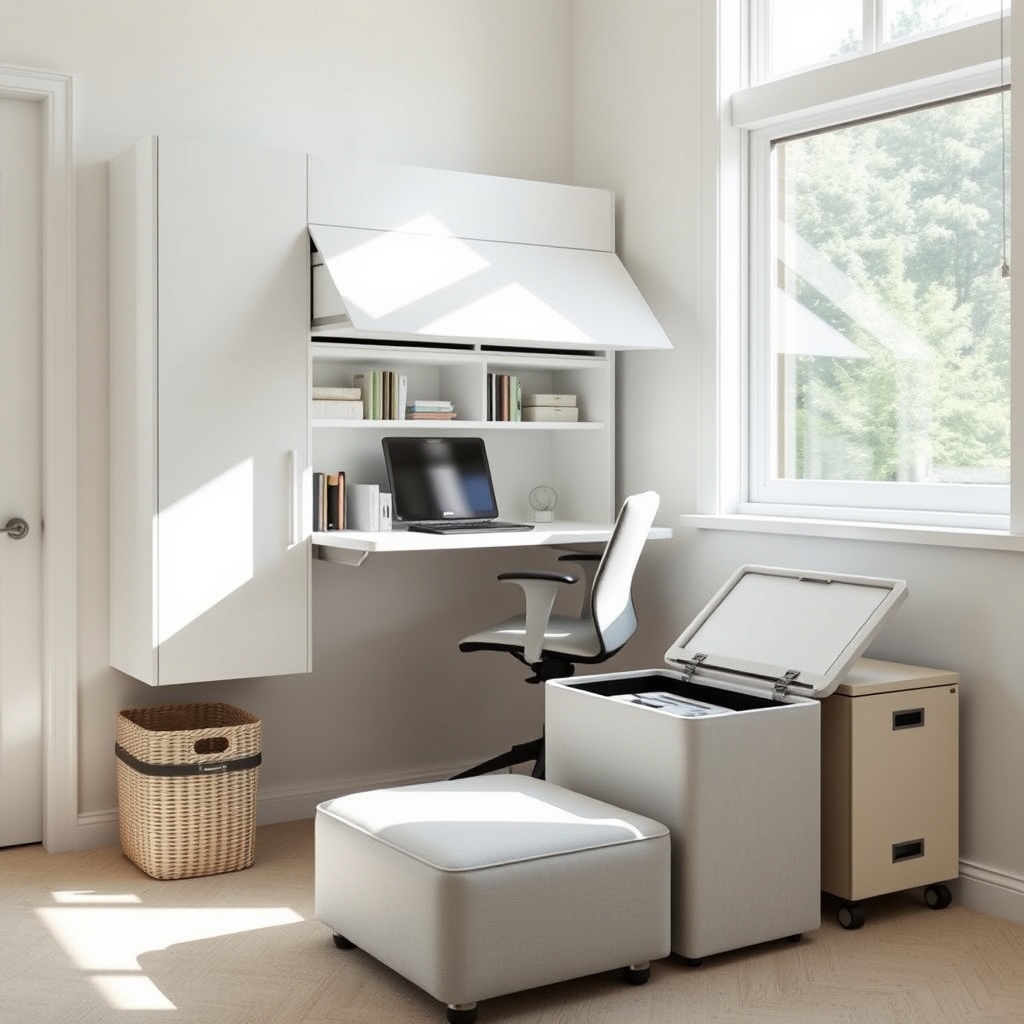
In today’s compact living spaces, furniture that serves multiple purposes has become essential for maximizing both functionality and square footage. Multi-functional furniture pieces not only help declutter spaces but also provide smart solutions for homes where rooms need to serve various purposes throughout the day.
Incorporating double-duty furniture requires careful planning and consideration of your specific needs, whether it’s a desk that transforms into a dining table or an ottoman with hidden storage. These versatile pieces can effectively bridge the gap between work and living spaces while maintaining organizational harmony.
Required Items:
- Measuring tape
- Floor plan or room dimensions
- List of daily activities and needs
- Storage containers
- Labels
- Furniture sliders
- Basic tools (screwdriver, Allen wrench)
- Cable management solutions
- Storage bins or baskets
- Desk organizers
Select furniture pieces that align with your primary and secondary needs. Start by identifying the main function of each room and then determine secondary uses. Choose items like murphy beds with built-in desks, storage ottomans, or expandable tables that can adapt to different scenarios.
Position these pieces strategically to maintain clear pathways and ensure easy transitions between functions. Consider vertical storage solutions and modular furniture systems that can be reconfigured as needed.
When setting up multi-functional spaces, establish clear zones for each activity. Use room dividers or strategic furniture placement to create distinct areas while maintaining flow. Implement a system where items can be quickly stored or accessed depending on the current use of the space.
For example, organize desk supplies in portable containers that can be easily tucked away when the surface needs to serve as a dining table.
Additional Tips: Maintain regular organization schedules to prevent clutter accumulation and ensure smooth transitions between functions. Use color-coding or labeling systems to quickly identify stored items, and invest in furniture with smooth-operating mechanisms for easy conversion.
Keep frequently used items in easily accessible locations and consider using furniture with wheels for maximum flexibility in space arrangement.
Hidden Storage Behind Workspace Walls
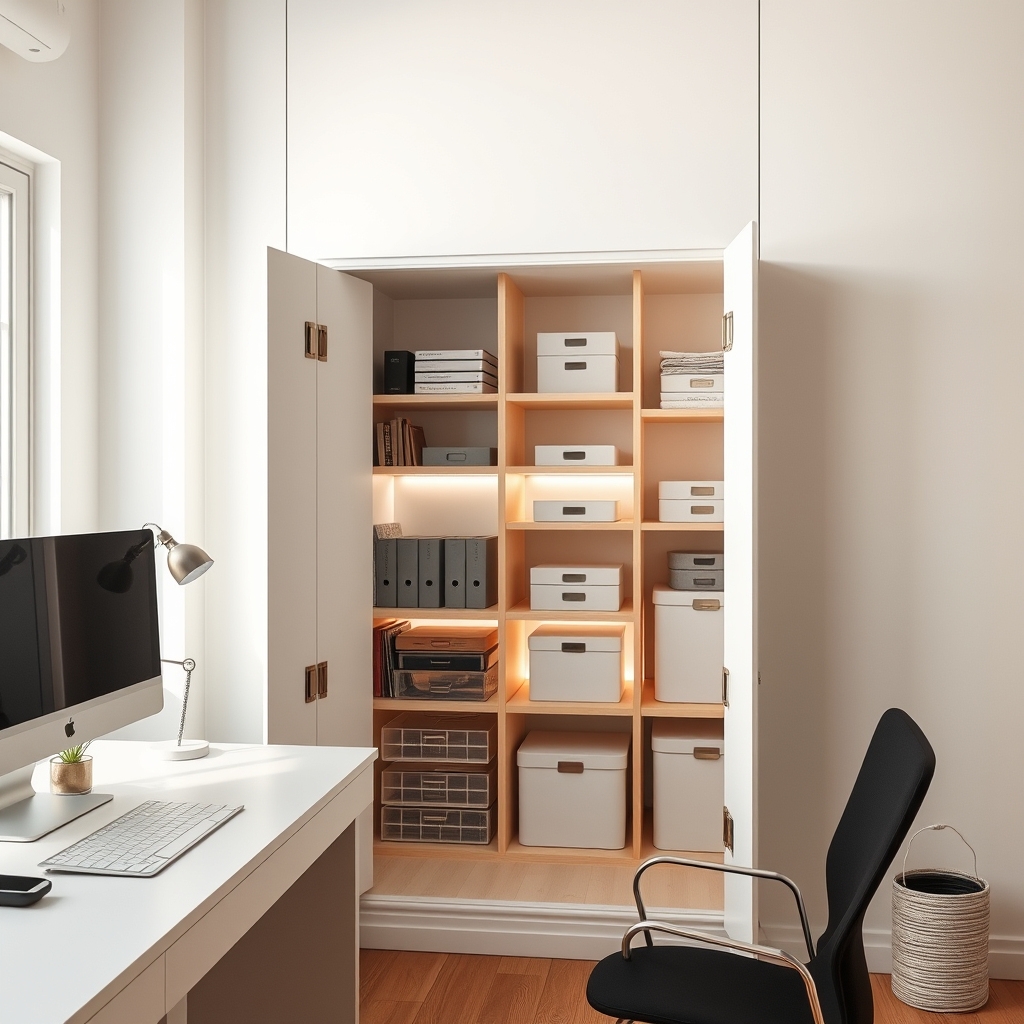
Maximizing storage space in a home office requires creative thinking, and one often overlooked area is the space behind workspace walls. This untapped real estate can transform into valuable storage solutions while maintaining a clean, minimalist aesthetic in your visible workspace.
Hidden storage helps reduce visual clutter and creates a more productive environment. Converting wall space into concealed storage areas not only maximizes square footage but also provides easy access to frequently used items without compromising the professional appearance of your workspace.
This organization method is particularly valuable for home offices where space is at a premium or where maintaining a sophisticated appearance is essential.
Required Items:
- Measuring tape
- Stud finder
- Level
- Drywall saw
- Wall anchors
- Shelving brackets
- Adjustable shelving
- Cabinet hinges
- Door handles or pulls
- Screwdriver
- Drill
- Wood panels or cabinet doors
- Paint or finish materials
- Storage containers
- Labels
Start by identifying suitable wall sections for hidden storage, using a stud finder to locate wall studs and checking for any electrical wiring or plumbing. Measure the space carefully and plan your storage configuration, considering both depth and height limitations.
Install sturdy wall brackets between studs to support shelving units or cabinet frameworks. Create access points by cutting precise openings in the drywall, ensuring they align with your planned storage space. Install door frames and hinges, then attach panels or cabinet doors that match your existing wall finish.
Consider using push-to-open mechanisms for a seamless look, or install discrete handles that complement your office design.
Organization Tip: Categorize items stored behind walls based on frequency of use, keeping frequently accessed items at eye level. Install motion-sensor lighting inside the storage space, and use clear containers with detailed labels to maintain efficient organization.
Consider creating a catalog or inventory system to track items stored in these hidden spaces, preventing the “out of sight, out of mind” syndrome that can lead to forgotten stored items.
Decluttering Strategies for Dual-Purpose Rooms
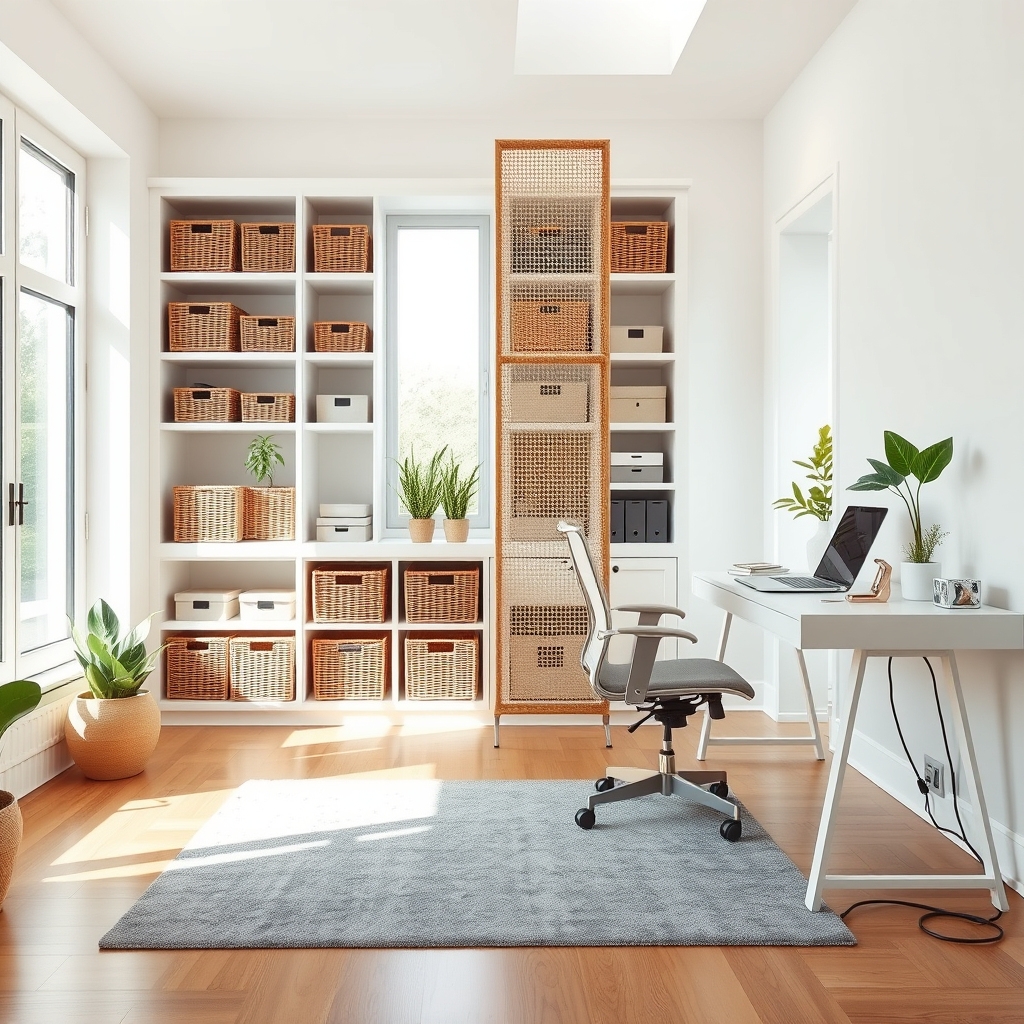
Dual-purpose rooms present unique challenges when it comes to organization, particularly when combining a home office with storage space. The key to success lies in creating distinct zones that serve each purpose while maintaining a cohesive and functional environment. Without proper organization, these spaces can quickly become cluttered and inefficient, leading to reduced productivity and increased stress.
Creating an effective system for a dual-purpose room requires careful planning and implementation of strategic storage solutions. The goal is to maximize available space while ensuring both the office and storage functions remain accessible and practical for daily use. A well-organized dual-purpose room can significantly improve workflow and make it easier to maintain order long-term.
Required Items:
- Storage containers in various sizes
- Label maker
- Shelving units
- Filing cabinet
- Desk organizers
- Storage bins
- Room divider or screen
- Drawer organizers
- Hooks and hanging systems
- Clear plastic containers
- Document folders
- Cable management solutions
Start by dividing the room into distinct zones – one for office work and another for storage. Use room dividers, furniture placement, or area rugs to create visual boundaries between spaces.
Next, assess all items in the room and sort them into three categories: office supplies, storage items, and items to be discarded or relocated. Install vertical storage solutions such as wall-mounted shelves or tall bookcases to maximize floor space.
For the office area, implement a filing system for documents and designate specific spaces for frequently used items. Use desk organizers and drawer dividers to keep supplies organized and easily accessible.
In the storage zone, utilize clear containers with labels for items that need to be stored long-term. Group similar items together and create an inventory system to track stored items’ locations.
Additional Tips:
Maintain the organization system by implementing a “one in, one out” rule for both office supplies and stored items. Schedule regular maintenance sessions to prevent clutter from accumulating, and review stored items quarterly to ensure they still deserve the space they occupy.
Consider using mobile storage solutions that can be easily moved when needed, and always keep pathways clear for safety and accessibility.
Smart Shelving Systems That Maximize Space
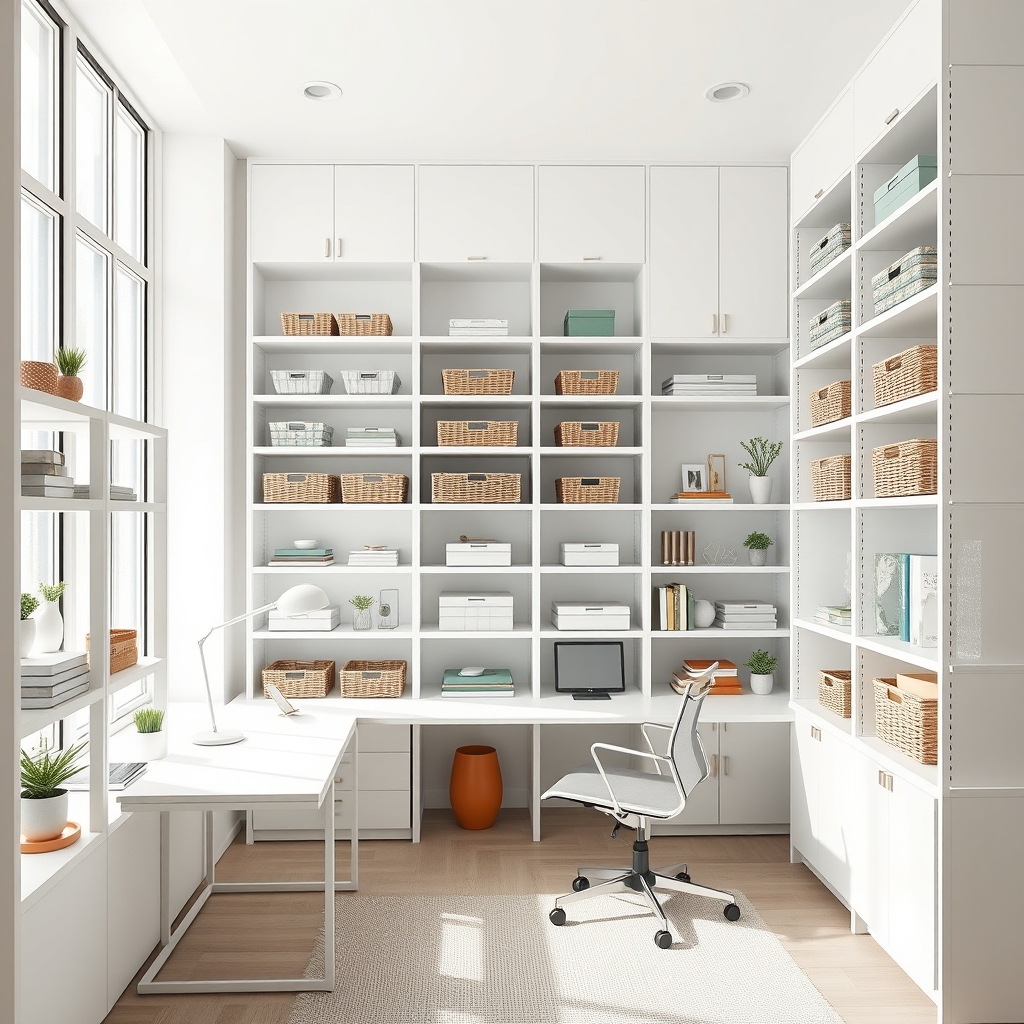
Efficient shelving systems serve as the backbone of any well-organized home office or storage space. When properly implemented, these systems transform cluttered, chaotic areas into streamlined environments that enhance productivity and reduce stress. The right shelving solution can effectively double or triple your usable space while keeping essential items easily accessible.
Maximizing vertical space through smart shelving is particularly crucial in today’s homes where square footage comes at a premium. Strategic shelf placement and organization not only creates more storage capacity but also contributes to a cleaner aesthetic and improved workflow, whether you’re working from home or managing household storage needs.
Required Items:
- Adjustable wall-mounted shelving tracks and brackets
- Various shelf sizes and materials
- Level and measuring tape
- Stud finder
- Power drill and screws
- Storage bins and containers
- Label maker
- Step ladder
- Shelf dividers
- Anchors for drywall installation
Start by assessing your wall space and mapping out your shelving configuration. Use a stud finder to locate wall supports and mark these points clearly. Install vertical tracking systems first, ensuring they’re perfectly level and securely anchored to wall studs.
Position brackets at varying heights to accommodate different storage needs, keeping frequently used items at eye level and less-used items higher up. For optimal organization, group similar items together and assign specific zones on your shelving system. Incorporate a mix of open shelving for easily accessible items and closed storage solutions for items that need protection from dust or visual clutter.
Use clear containers for smaller items and implement a consistent labeling system to maintain order.
Additional Tips: Incorporate adjustable shelving components to adapt to changing storage needs over time. Leave some empty space for future items and consider installing task lighting under shelves to illuminate work areas. Regularly reassess your organization system and adjust shelf heights and zones based on usage patterns.
Remember to secure heavy items on lower shelves and use proper wall anchors for safety.
Creating Zones for Work and Storage
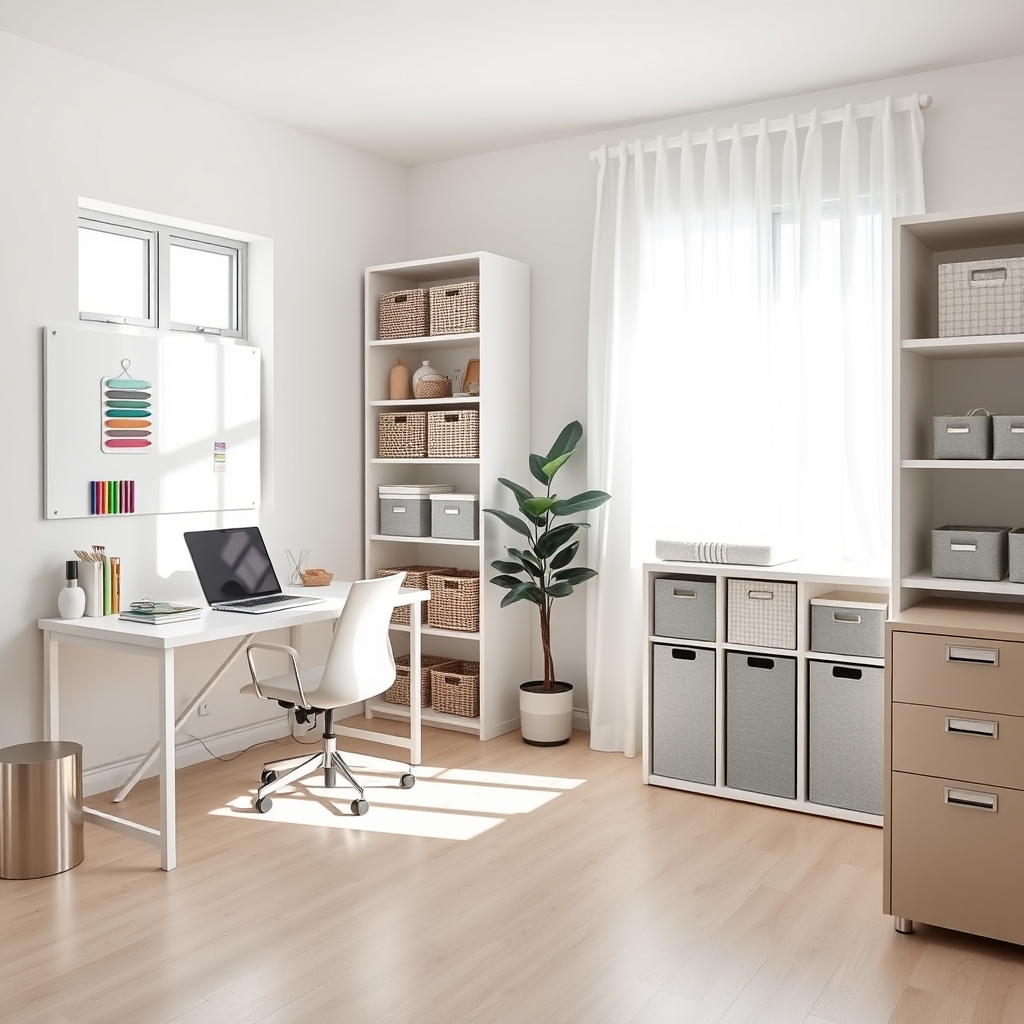
A well-organized workspace that combines both office and storage functions is essential for maintaining productivity and reducing stress. When work materials and stored items compete for space, it can lead to chaos and inefficiency, making it difficult to focus on tasks or locate important items when needed.
Creating distinct zones for work and storage helps establish boundaries between different activities while maximizing available space. This systematic approach ensures that work materials remain separate from stored items, preventing cross-contamination of spaces and maintaining a professional atmosphere in the work area while keeping storage accessible and orderly.
Required Items:
- Measuring tape
- Storage containers
- Labels and label maker
- Shelving units
- Filing cabinets
- Desk and chair
- Room dividers or screens
- Storage bins
- Cable management solutions
- Drawer organizers
Start by measuring your space and creating a floor plan that designates specific areas for work and storage. Position the desk in a location with natural light and minimal distractions, ideally facing a wall or window.
Install shelving units and storage solutions along the walls, creating a clear separation between the workspace and storage area. Use vertical space efficiently by installing floor-to-ceiling shelving units in the storage zone.
For the work zone, arrange essential office supplies and equipment within arm’s reach of the desk. Set up a filing system for current projects and frequently accessed documents.
In the storage zone, organize items by category and frequency of use, placing rarely-used items in higher or less accessible spaces while keeping frequently-needed items at eye level.
Consider implementing a color-coding system or numbered zones to make item location more intuitive. Store similar items together and use clear containers to easily identify contents.
Label everything meticulously and maintain an inventory system for stored items. This organization method will save time and prevent the zones from gradually merging over time.
Organizing Your Digital and Physical Files Together
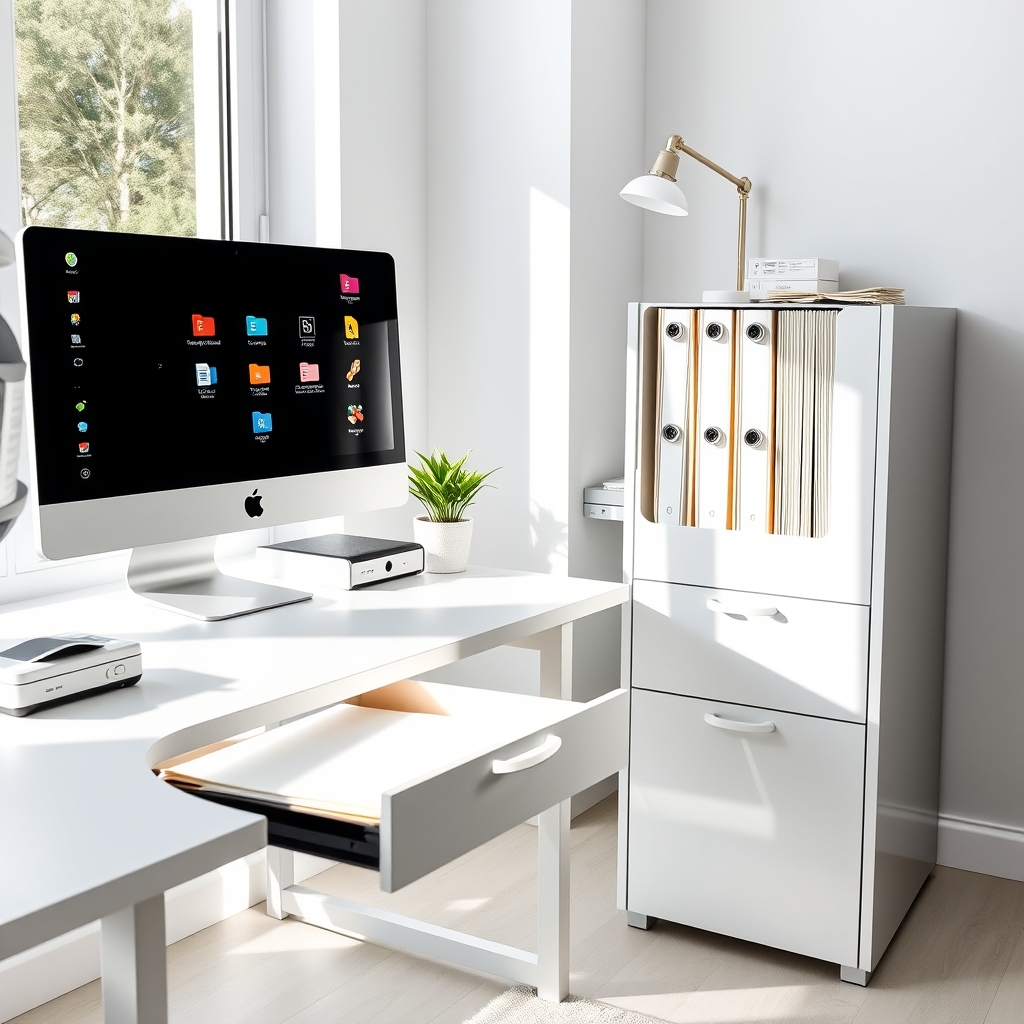
In today’s hybrid work environment, maintaining both digital and physical filing systems has become increasingly important. A well-organized system that bridges both worlds not only saves time but also reduces stress and increases productivity by ensuring that important documents are always accessible, regardless of their format.
Creating a synchronized organization system between physical and digital files eliminates redundancy and confusion while maximizing storage efficiency. When digital and physical files mirror each other, it becomes easier to maintain records, locate important documents quickly, and ensure that nothing falls through the cracks during critical business or personal tasks.
Required Items:
- Filing cabinet
- File folders
- Label maker
- External hard drive
- Cloud storage subscription
- Scanner
- Document management software
- Storage boxes
- Hanging folders
- File naming guide template
- Shredder
- Index cards
Start by creating a unified filing structure that works for both physical and digital storage. Develop main categories (such as Financial, Medical, Personal, and Work) and establish subcategories within each. Set up your physical filing cabinet with labeled folders matching these categories. Create identical folder structures on your computer and cloud storage.
Scan existing physical documents that need digital backup, saving them in their corresponding digital folders using a consistent naming convention. For ongoing organization, establish a processing center where new documents can be immediately sorted. When receiving physical documents, immediately decide if they need digital copies and scan them accordingly.
For digital files, determine if physical copies are necessary for legal or practical purposes and print them if required. Maintain a master index in both digital and physical form that lists the location of all important documents.
Additional Tips: Implement a regular maintenance schedule to review and purge unnecessary files in both systems. Use color coding to match physical and digital folders for quick visual reference. Consider implementing a “one-in-one-out” policy to prevent accumulation of unnecessary documents.
Always maintain backup copies of critical documents in both formats, and store them in separate locations for security. Review and update your organization system quarterly to ensure it continues to meet your evolving needs.

